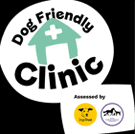Want to know the facts and how to avoid ticks this season? As we approach the warmer months, when ticks like to make an appearance, we wanted to give our pet owners a head start in preparing to tackle ticks!
Ticks live in tall grass and wooded areas such as trees, shrubs and leaf piles, particularly cool, moist, mature woods with thick undergrowth. They enjoy waiting in the underbrush for an animal or human to brush by, and then grasp the fur or skin and crawl up the leg. They don’t fly, jump or drop from trees. In the current circumstances, it may well be that people visit local areas of grassland and woodland in order to distance themselves from other dog walkers and come into more regular contact with ticks.
Although tick bites are often harmless, they can cause allergic reactions and certain ticks can pass diseases onto humans and pets when they bite, which can be dangerous.
Dogs and cats pick up ticks very easily, and dogs in particular are susceptible to tickborne diseases. Vaccines are not available for most of the tickborne diseases that dogs can get, and they don’t prevent your dog from bringing ticks into your home. For these reasons, it’s important to use a tick preventive product on your dog.
Ticks and their bites may be hard to detect. Signs of tickborne disease may not appear for 7-21 days or longer after a tick bite, so watch your dog closely for changes in behaviour or appetite if you suspect that your pet has been bitten by a tick.
Currently we are open for urgent or emergency consultations, but are still able to provide advice regarding:
- The best tick prevention products for your dog
- Tickborne diseases in your area
To further reduce the chances that a tick bite will make your dog sick:
- Check your pets for ticks daily, especially after they spend time outdoors.
- If you find a tick on your pet, remove it right away
In these very worrying times, we can arrange to dispense tick prevention products for you, whilst maintaining stringent social distancing to protect you, our colleagues and the most vulnerable people in our society.
How to remove a tick
Step 1: Put on some gloves
There is little risk of the tick affecting you, so thoroughly washing your hands first will be adequate. Wearing gloves can prevent any infectious germs from the tick affecting you or your furry friend so if you have gloves available, wear them.
Step 2: Keep your pet calm
It is important to keep your pet calm and if somebody is available to help, they can keep your pet relaxed whilst you remove the tick. Perhaps distract them with some treats?
Step 3: Tweezers at the ready
It is also important not to squeeze the body of the tick, as this could force potentially harmful germs from the tick into your pet’s bloodstream.
The best instrument to use is a “tick removal hook” which is passed under the tick and then turned gently around until the tick releases comes away.
Failing this, take a pair of tweezers and grasp onto the tick as close to your pet’s skin as possible. Grabbing close to the skin is the best way to get a tick head out but be careful not to pinch your pet’s skin!
Please see a link to official tick removal advice: https://lymediseaseuk.com/2015/10/26/tick-removal/
Step 4: Pull out the tick.
If using a tick hook, keep turning the hook using the instructions included in the pack until it releases.
If using tweezers, gently pull the tick straight out taking your time and remaining steady. Do not twist or suddenly pull as you don’t want to leave the tick’s head or mouth behind.
After removing the tick, examine it to make sure the head and mouthparts were removed. If not, please call your vet for advice on removing any remaining tick parts.
Step 5: Get rid of the tick
Kill the tick by placing it in a container with rubbing alcohol.
Once the tick is dead, we recommend keeping it in the container with a lid in case your pet begins displaying symptoms of disease.
There are many types of ticks, and each carry different kinds of diseases, so keeping the tick can help your vet make a proper diagnosis should you pet become poorly.
Step 6: Disinfect the bite.
You can use triple-antibiotic spray or wipes to disinfect the bite site, or you can use over-the-counter chlorhexidine solution to clean the area.
Keep an eye on it for signs of infection. If the skin remains red or becomes inflamed, please call your vet for advice.












